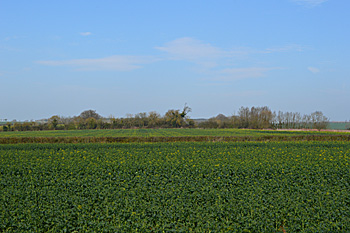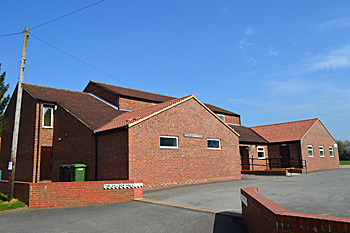The Parish of Riseley in General

A field near the church April 2015
Landscape
Like most of north Bedfordshire, Riseley is not particularly high. The church stands at 203 feet above sea-level and the lower school at 198 feet. Margaret Beaufort Middle School is at 180 feet.
The solid, or underlying geology is divided between two types of formation – Oxford Clay and Blisworth Limestone. Oxford Clay Formation is a mudstone, formed approximately 154 to 164 million years ago in the warm, shallow seas of the Jurassic Period. Blisworth Limestone Formation is older, laid down between 164 to 169 million years ago in the Jurassic. Oxford Clay predominates in the village and the south of the parish with Blisworth Limetone north-west of the High Street and in the northern part of the parish
The soils are varied. Alluvium, a mix of clay, silt, sand and gravel formed by river action is found along water courses. Glaciofluvial deposits of sand and gravel formed during Ice Ages occurs just west of the chapel, south of Sackville Lodge and east of Coppice Wood. River Terrace Deposits of sand and gravel are found south-west of the village and a diamicton called Oadby Member, again formed during Ice Ages is found east and west of the village.

Name
The origin of the name 'Riseley' are not certain. In their seminal volume of 1926 on the place names of Bedfordshire and Huntingdonshire, A Mawer and F M Stenton suggest that it may be derived from the Old English 'hris-leah', meaning 'brushwood clearing'. They also propose origins within personal names, such as 'Risan-leah or 'Risa'. Their book provides a list of the variations of the name over time:
- Riselai: 1086-1156;
- Rislie: 1198;
- Risle(e): 1202-1352;
- Rissle: 1202
- Risele: 1202-1276;
- Riseleg(a): 1219-1255;
- Risley: 1219;
- Rissele: 1255-1276;
- Rysle: 1280-1316;
- Rys(e)legh: 1276;
- Rissele, also Rysle: 1319;
- Rysele(y): 1351-1489;
- Riesle: 1490-1504;
- Riseley or Risley: 1750;
- Risley: 1785-1820
 The Village Hall April 2015
The Village Hall April 2015
Administrative History
Riseley is an ancient parish in the Stodden Hundred. It is surrounded by Melchbourne to the north-west, Swineshead to the north-east, Keysoe to the east, Thurleigh to the south-east, Bletsoe to the south and Knotting to the south-west.

135 High Street April 2015
Population
The Domesday Book of 1086 contains six entries for Riseley, listing a total of 25 inhabitants. As these individuals would have been heads of households, this number should be multiplied by at least four to provide an idea of the actual figure. This suggests a population of around 100, an average sized parish for the time.
Census figures from 1801-2011 show changes set out below. The population of Riseley is seen swelling and then shrinking over the nineteenth century, possibly initiated by the agricultural depression. The population ultimately dropped below 1801 numbers by the 1930s. However, in later years, between 1961 and 2011, the population more than doubled as new houses have been built.
- 1801: 576
- 1811: 650
- 1821: 790
- 1831: 871
- 1841: 971
- 1851: 949
- 1861: 1,026
- 1871: 1,028
- 1881: 958
- 1891: 839
- 1901: 735
- 1911: 663
- 1921: 600
- 1931: 528
- 1951: 525
- 1961: 554
- 1971: 921
- 1981: 1,119
- 1991: 1,296
- 2001: 1,284
- 2011: 1,286